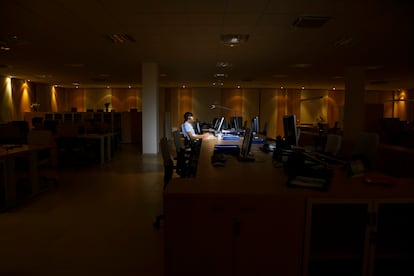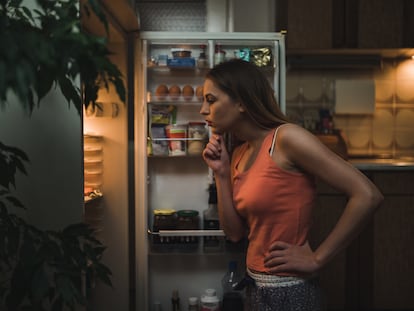Working in areas with no access to natural light ‘is a risk factor in occupational health’
Various studies show that exposing workers to nothing but artificial lighting puts their physical and mental health in danger

Doctor Juan Antonio Madrid, a professor of physiology at the University of Murcia in Spain and author of Cronobiología: una guía para descubrir tu reloj biológico [Cronobiology: a guide to discovering your biological clock], explains that human beings as a species have evolved characteristics related to living outside during the day, with a very intense natural light that on sunny days can often rise above 50,000 and 100,000 lux. However, he notes, in a one-thousandth part of that evolution, over the last 100-150 years, humans have begun “to isolate their bodies from sunlight,” to live and work indoors, with artificial light intensities of just 100, 200 or 300 lux. “Those intensities are very different compared to natural light’s thousands of lux. It is strange, because our eye does not perceive the difference, but the truth is that we cannot spend our lives indoors without contact with sunlight. We recommend at least two hours of exposure to natural sunlight every day, preferably in the first half of the day,” he says.
Today, those two hours of exposure to sunlight are a pipe dream for many. There was a time during which jobs like mining were the only ones that involved employees working without exposure to natural light. But today, a very high percentage of the population works in stores and offices that, in many cases, don’t even have windows that give access to natural light. “We have normalized working in caves without natural light because we get reflected light from our screen, because it makes us hot, because the sun bothers us, and this is reducing the differences between day and night. But that contrast is essential for keeping our biological clock synchronized and, as a result, enjoying good circadian health,” says María José Martínez Madrid, coordinator of the Chronobiology work group at the Spanish Sleep Society (SES).
The expert says that to be exact, it’s our sleep that is one of the great victims of this lack of exposure to natural daylight: “We know that light, especially blue light at night, inhibits the secretion of melatonin, the sleep hormone, so if we are exposed to light at night, our sleep is impacted. There is also evidence that, for correct melatonin synthesis and secretion at night, it is essential to expose oneself to natural light first thing in the morning. If melatonin is not synthesized, it can make it difficult to fall asleep and when we are able to fall asleep, our slumber will be more superficial, less deep and less restful,” she says.
The need for natural light in the workplace
As Cristina Nicolau Llobera, member of the Neurophysiology of Sleep and Biological Rhythms research group at the University of the Balearic Islands, laments, “there is a gap between the importance of natural light for human beings and the amount of research that is done on the subject.” But there have been several studies carried out on the subject in recent years. According to one from 2014 published in the Journal of Clinical Sleep Medicine, for example, when compared to people who work in offices without windows, employees with windows in their workplace have greater exposure to light during the work week, tend to do more physical activity and sleep for longer durations.
Another 2015 study published in Chronobiology International concludes that lack of exposure to natural light at work is related with high levels of cortisol and low levels of melatonin at night, which is itself related to depressive symptoms and a poorer quality of life. More recently, in 2020, another study published in the International Journal of Environmental Research and Public Health concluded that having windows in the workplace that allow access to natural light and pleasant views helped to increase employees’ sleep by an average of 37 minutes, and workers scored 42 percent higher in cognitive simulations designed to assess their ability to make decisions.
“Until very recently, the need for good lighting in the workplace has not been given the importance it deserves, with other factors such as air conditioning, décor, security and comfort taking priority. Lately, regulations on workplace conditions do include the issue of lighting as a relevant aspect. But they always refer to artificial light. It’s true that a lot of progress has been made in artificial lighting, but there are many studies that show that natural lighting is preferable to artificial sources,” says Nicolau Llobera.
According to the expert, when occupational, social and environmental pressures interrupt control of one’s circadian rhythms, the resulting desynchronization in our circadian physiology can predispose us to altered levels of stress and lifestyle changes: a worse diet, greater consumption of alcohol, smoking tobacco, self-medicating, lack of exercise, lack of sleep, etc., and give rise to nutritional risks such as vitamin D deficiency. All this translates, among other things, into greater sleepiness during the day, mood impairment due to a lack of dopamine and serotonin, more fatigue, poorer cognitive performance, which brings with it lower levels of productivity (“not only because of the sleep problems, but also because a lack of natural light can affect concentration and attention”); and greater prevalence of chronic diseases such as obesity, diabetes, cardiovascular disease, cancer and depression.
“Depriving a person of natural light on a daily basis is going to detract from their mental health. Not only will it help to see trees, greenery, or other kinds of different stimulants you don’t find in an office through a window; but also because the effect of natural light is a per se antidepressant,” says the University of Murcia professor, who adds that being able to look through windows during working hours also reduces eyestrain, by allowing the lens to adjust to the far distance, to the sight of infinity, which produces ocular relaxation. “If you are always in an enclosed space, with no possibility of seeing beyond the walls of your office, you have a problem.”
For Madrid, one handicap of studies that have analyzed the health impacts as lack of light has in the workplace is the difficulty of separating the role of light from those played by other factors such as a sedentary lifestyle or having a screen just a few centimeters from one’s eyes. “What is clear is that it is practically certain that a person who is hardly exposed to natural light and who is also sedentary will have sleep disturbances. It is a vicious circle that is in turn related to a string of diseases linked to lack of sleep that, indirectly, are also conditioned by the lack of exposure to natural light during the day,” argues the expert, who thinks that based on existing evidence, working in offices with no natural light, or even artificial light that approximates natural light’s spectrum and intensity, should be considered “a risk factor in occupational health.”
How to improve or make up for a lack of light in the workplace
Since ideally, one should be exposed to natural light outdoors, above all first thing in the morning, Martínez Madrid points out that one of the ways to alleviate negative effects of lack of light in the workplace is for employees to walk to and from work as much as possible. “It’s also important for them to take coffee or lunch breaks outdoors, or at least in front of the light of large windows, and to go outside whenever possible, for example, to make a work call,” she says.
Another solution, according to Madrid, would be to use RBG lighting systems in offices that attempt to simulate the percentages of radiation emitted by sunlight. He recommends using LED lighting systems that can increase light intensity in workplaces to between 500 and 1,000 lux, the light intensity needed to activate the circadian system during the day, according to estimates.
To that end, Nicolau Llobera highly recommends that in workplaces with evening or late-night shifts, dynamic lighting (white light during the day, warm light at night) be used to better simulate sunlight: “Even though the new generation of LEDs can loosely approximate the spectral distribution of daylight and can be programmed to vary in intensity and correlated color temperature throughout the day to simulate daylight, as well as the important transitions between sunrise and sunset, a new focus on natural light is required, such as illumination studies during the design of workplaces or architectural solutions to achieve better energy efficiency. In any case, whenever possible there should be ample windows and positioning of workers by those windows; also, breaks for workers so they can go outside and periodically be exposed to sunlight.”
If these measures aren’t possible, experts suggest the use of light therapy lamps, which simulate the biological effect of sunlight by emitting a very high light intensity (between 5,000 and 10,000 lux). “You can use them for a half-hour while having breakfast, a cup of coffee or reading the newspaper, and they are also an option for workplaces,” says Madrid. However, as Martínez Madrid points out, to avoid disturbing and hindering nighttime sleep, these lamps — whose use should be monitored by a specialist and used in such a way so that their light doesn’t cause discomfort — should only be used during the first half of the day by people whose lifestyle prevents them from being exposed to natural light.
Sign up for our weekly newsletter to get more English-language news coverage from EL PAÍS USA Edition
Tu suscripción se está usando en otro dispositivo
¿Quieres añadir otro usuario a tu suscripción?
Si continúas leyendo en este dispositivo, no se podrá leer en el otro.
FlechaTu suscripción se está usando en otro dispositivo y solo puedes acceder a EL PAÍS desde un dispositivo a la vez.
Si quieres compartir tu cuenta, cambia tu suscripción a la modalidad Premium, así podrás añadir otro usuario. Cada uno accederá con su propia cuenta de email, lo que os permitirá personalizar vuestra experiencia en EL PAÍS.
¿Tienes una suscripción de empresa? Accede aquí para contratar más cuentas.
En el caso de no saber quién está usando tu cuenta, te recomendamos cambiar tu contraseña aquí.
Si decides continuar compartiendo tu cuenta, este mensaje se mostrará en tu dispositivo y en el de la otra persona que está usando tu cuenta de forma indefinida, afectando a tu experiencia de lectura. Puedes consultar aquí los términos y condiciones de la suscripción digital.
More information
Últimas noticias
Most viewed
- Christian Louboutin: ‘Young people don’t want to be like their parents. And if their parents wear sneakers, they’re going to look for something else’
- ‘El Limones’ and the growing union disguise of Mexican organized crime
- Cartels in Mexico take a leap forward with narco-drones: ‘It is criminal groups that are leading the innovation race’
- ‘We are dying’: Cuba sinks into a health crisis amid medicine shortages and misdiagnosis
- The low-cost creative revolution: How technology is making art accessible to everyone











































